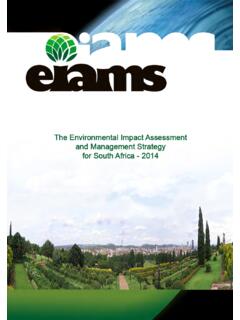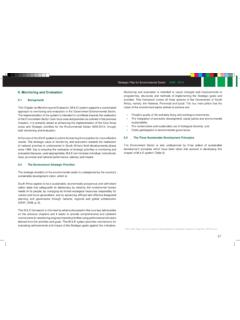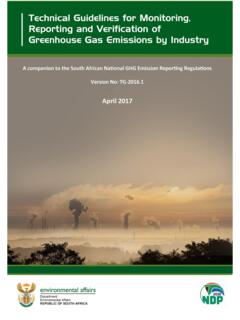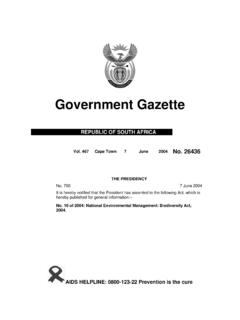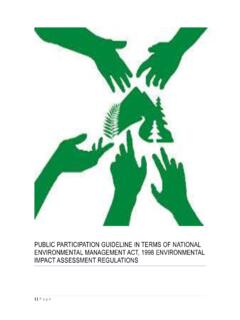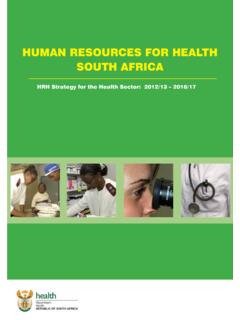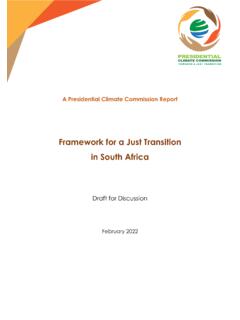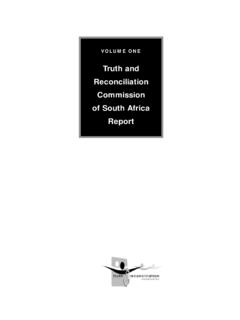Transcription of Chapter 13 Waste management - Department of …
1 Waste management | 277 Chapter 13 Waste managementFor the Waste sector in south africa this means care must be given to raw material use, product design, resource efficiency, Waste prevention, and minimization where avoidance is management | 278 Chapter THE SOCIO-ECONOMIC CONTRIBUTION OF south africa S Waste management SYSTEM Employment creation Municipal revenue Capital investment in the Waste LEGAL MANDATES AND FUNCTIONAL RESPONSIBILITIES Constitutional and legal framework Roles and responsibilities south africa s international DRIVERS OF AND PRESSURES ON Waste GENERATION IN south africa Socio-economic drivers Environmental drivers Institutional Waste DISPOSAL AND TREATMENT IN south africa Waste management trends in south africa Hazardous PUBLIC AND PRIVATE SECTOR RESPONSE National PROVINCIAL AND LOCAL GOVERNMENT S RESPONSE Status of IWMPs in south africa Private sector
2 COMPLIANCE MONITORING AND ENFORCEMENT Environmental management INTRODUCTIONS outh africa s commitment to sustainable development is aimed at balancing the broader economic and social challenges of a developing and unequal society while protecting environmental resources. For the Waste sector in south africa this means care must be given to raw material use, product design, resource efficiency, Waste prevention, and minimization where avoidance is , economic development, a growing population and increasing rates of urbanization in south africa have resulted in increased Waste generation which requires establishing and implementing effective Waste management policies and programmes. A number of issues continue to be challenges for effective Waste management .
3 These include ineffective data collection systems and lack of compliance and enforcement capacity, lack of education and awareness amongst stakeholders within the Waste sector, operational costs for management of Waste , support for Waste reduction at local government level, availability of suitable land for Waste disposal, lack of structured incentives for reduction, and recycling and/or reuse of Waste (DEA 2009a). The official country problem statement according to the National Waste management Strategy (NWMS) (DEA 2012a) lists the following as the major challenges faced by south africa in the Waste management arena: Waste management | 279 A growing population and economy, which means increased volumes of Waste generated. This puts pressure on Waste management facilities which are already in short supply; Increased complexity of the Waste stream due to urbanization and industrialization.
4 The complexity of the Waste stream directly affects the complexity of its management , which is compounded when hazardous Waste mixes with general Waste ; A historical backlog of Waste services for urban informal areas, tribal areas and rural formal areas. Although 61 per cent of all south African households had access to kerbside domestic Waste collection services in 2007, this access remains highly skewed in favour of more affluent and urban communities. Inadequate Waste services lead to unpleasant living conditions and a polluted, unhealthy environment; Limited understanding of the main Waste flows and national Waste balance because the submission of Waste data is not obligatory, and where data is available, it is often unreliable and contradictory; A policy and regulatory environment that does not actively promote the Waste management hierarchy.
5 This has limited the economic potential of the Waste management sector, which has an estimated turnover of approximately R10 billion per annum. Both Waste collection and the recycling industry make meaningful contributions to job creation and GDP, and they can expand further; Absence of a recycling infrastructure which will enable separation of Waste at source and diversion of Waste streams to material recovery and buy-back facilities; Growing pressure on outdated Waste management infrastructure, with declining levels of capital investment and maintenance; Waste management suffers from a pervasive under-pricing, which means that the costs of Waste management are not fully appreciated by consumers and industry, and Waste disposal is preferred over other options; Few Waste treatment options are available to manage Waste and so they are more expensive than landfill costs.
6 And, Too few adequate, compliant landfills and hazardous Waste management facilities, which hinders the safe disposal of all Waste streams. Although estimates put the number of Waste handling facilities at more than 2000, significant numbers of these are definition of Waste derived from NEM:WA states that: Waste means any substance, whether or not that substance can be reduced, re-used, recycled or recovered: That is surplus, unwanted, rejected, discarded, abandoned or disposed of Which the generator has no further use of for the purposes of production That must be treated or disposed ofThat is identified as a Waste by the Minister by notice in the Gazette, and includes Waste generated by the mining, medical or other sector, but (i) a by-product is not considered Waste ; and (ii) any portion of Waste , once re-used, recycled or recovered, ceases to be Waste .
7 The management of Waste in south africa has been based on the principles of the Waste management hierarchy (Figure ) from early Waste policy (DEAT 2000) and entrenched in recent Waste legislation. The adoption of the hierarchy has been in the policy since 2009, but the management of Waste has not necessarily followed the hierarchal approach. It is only as a result of the promulgation of the NEM:WA and finalization of the NWMS that the implementation of the hierarchy approach was prioritized. management of Waste through the hierarchal approach is a recognized international model for the prioritization of Waste management options. It offers a holistic approach to the management of Waste materials, and provides a systematic method for Waste management during the Waste lifecycle addressing in turn Waste avoidance, reduction, re-use, recycling, recovery, treatment, and safe disposal as a last resort.
8 This aims to eventually reduce the reliance of south africa s Waste disposal on landfills, as currently the majority of Waste ends up African Waste legislation is influenced and informed by the key elements of the Waste hierarchy, which dictates the overall strategic approach for Waste management . The Waste hierarchy is also clearly visible in the NWMS for south africa (DEA 2012a).Figure 13. 1: Waste management hierarchy as per the National Waste management StrategySource: DEA (2012a)This approach towards Waste management emphasizes the following key elements (DEA 2012a): Avoidance and Reduction: Products and materials must be designed in a manner that minimizes their Waste components or in a manner that reduces the natural material quantities used and potential toxicity of Waste generated during the production, and after use; Re-use: Materials can be used for similar or different purposes without changing form or properties.
9 This approach seeks to re-use a product when it reaches the end of its life span. In this way, it becomes input for new products and materials; Recycle: This involves separating materials from the Waste stream and processing them as products or raw materials. The first elements of the Waste management hierarchy are the foundation of the cradle-to-cradle Waste management approach; Recovery: Reclaiming particular components or materials or using the Waste as a fuel; Waste avoidance and reductionRe-useRecyclingRecoveryTreatmen t &disposalWaste management | 280 Treatment and disposal: This is a last resort within the Waste hierarchy. Treatment refers to any process that is designed to minimize the environmental impact of Waste by changing the physical properties of Waste or separating out and destroying toxic components of Waste .
10 Disposal refers specifically to the depositing or burial of Waste onto, or into land; and, Legal: Processing, treatment, and disposal of Waste must take place in accordance with the principles of environmental justice and equitable access to environmental services as articulated in the this Chapter , an overview of the status of Waste management in south africa is presented, based on key drivers. Specific focus is placed on the Waste management hierarchy within the context of south africa s 2012 NWMS, and the NEM:WA. It is according to this Waste management hierarchy that all Waste management practices across the country are south African Waste management policy framework is presented. Attention is drawn towards national and international legislation and how it has affected the decisions of Waste management mandatory functions within the spheres government, particularly in the last decade.


